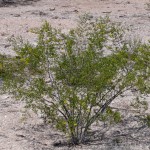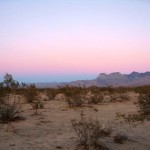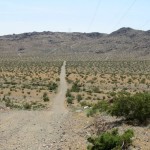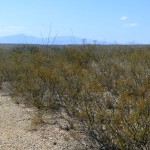Introduction
Larrea tridentata (creosote) ranges from the deserts of southern California to Texas and deep into Mexico. It may be the most far-ranging shrub in North America. It is found from about sea level to over 4,500 ft.
Details
If plants are randomly distributed, you would expect to find some that are growing in clumps and some that are very far apart. The pattern of creosote distribution is not random; clumps are unusual and the plants are often evenly distributed over an area. Statistically speaking, the plants are non-randomly distributed. They are not spaced in a grid, but they do not grow just anywhere.
The question is why their spacing is non-random. The answer may be that the individual plants compete with each other for nutrients and water. The desert soils are often deficient in both. Two plants growing at a some distance from each other may prevent the establishment of seedlings between them by using up all water and nitrogen, etc.
Thus, plants growing too close together will fight for resources and one (or both) will eventually wither away. The competition for resources keeps the plants at a distance from each other. The distance between plants is not specific, but it is non-random. Clumping is the exception, not the rule. Spacing is the rule.
There are other mechanisms that could be responsible for the non-random spacing of the shrubs. The plant roots could communicate with each other by releasing chemicals into the soil, and the chemicals could send a message, “I’m here already, don’t bother sending your roots this way.” Communication might actually be through deadly chemicals that cause each plant to keep its distance from neighbors.
Additional Reading: Annual Plants Associated with Creosote
Additional Reading: Communication Between Desert Shrubs






There are also the possible explanations of seed distribution mechanisms and seed predation. It has been shown that rodent seed predation can be more efficient on clumped seeds than widely scattered seeds. OJ Reichman “Desert granivore foraging and its impact on seed density and distributions” Ecology (1979) 60(6): 1085-1092
Hi Patic,
Seed distribution and predation are mechanisms I didn’t consider. I think they could explain what we see. Thanks for the insight.
Joe